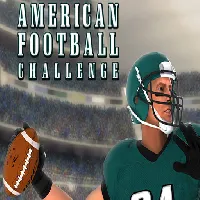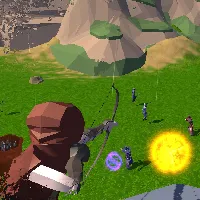AMERICAN FOOTBALL KICKS
SIMILAR GAMES
Description
AMERICAN FOOTBALL KICKS - GamePluto
About AMERICAN FOOTBALL KICKS - GamePluto
In the dynamic and thrilling world of American football, the kick is often the unsung hero, the moment of precision and power that can dramatically alter the course of a game. From the initial kickoff that sets the tone, to the game-winning field goal under immense pressure, American football kicks are a fundamental and captivating element of the sport. At GamePluto, we delve deep into the intricacies, strategies, and sheer athleticism involved in every type of kick, aiming to provide a comprehensive understanding for enthusiasts and newcomers alike. We explore the diverse roles these crucial plays fulfill, showcasing the dedication and specialized skill sets required from the athletes who execute them.
The Art and Science of American Football Kicks
American football kicks are far more than just propelling a ball through the air; they represent a delicate interplay of physics, biomechanics, and strategic execution. Each kick demands a unique approach, tailored to its specific purpose within the game. The development of a skilled kicker is a long and arduous journey, involving countless hours of practice, refining technique, and building both physical strength and mental fortitude. We believe that a thorough understanding of these kicks enhances the appreciation of the sport, revealing the sophistication behind each successful boot.
The Opening Salvo: Kickoffs
The kickoff is the explosive start to every half of an American football game, and its impact is often underestimated. It’s not merely about sending the ball downfield; it’s a strategic play designed to gain territorial advantage, disrupt the opposing team’s momentum, and sometimes even secure an immediate scoring opportunity through a surprise onside kick. Kickers must master the ability to generate maximum distance and hang time, forcing the receiving team’s returners to make difficult decisions deep within their own territory. The accuracy and power required are immense, as a poorly executed kickoff can easily give the opposition favorable field position. The evolution of the kickoff has seen techniques adapt, from the traditional sky kick to the modern onside kick, each carrying its own set of risks and rewards. The objective is to push the ball as far as possible, ideally into the end zone for a touchback, or to pin the returner back, limiting their ability to advance the ball significantly. The strategic deployment of kickoffs can set the psychological tone for the entire game.
The Crucial Conversion: Extra Points and Field Goals
When a team scores a touchdown, the opportunity arises for an extra point kick or, in more challenging situations, a field goal. These kicks, while often shorter than kickoffs, carry immense pressure due to their direct impact on the scoreboard. The extra point, typically from a closer distance, is expected to be a routine conversion, yet even these can be missed under duress. Field goals, on the other hand, can range from relatively short to extraordinarily long, demanding exceptional accuracy and leg strength. The success of these kicks relies on a perfectly synchronized operation involving the long snapper, the holder, and the kicker. The holder’s role is vital; they must catch the snap cleanly and place the ball precisely for the kicker, ensuring a stable platform for the boot. The kicker’s ability to maintain composure under pressure is paramount, as a missed field goal can mean surrendering valuable points and potentially losing a close contest. The trajectory and accuracy required are honed through years of dedicated practice. We examine the technical nuances that separate a good kicker from a truly great one in these critical scoring situations.
The Strategic Gambit: Punts
The punt is a fundamental aspect of American football, employed when a team faces a fourth down and is too far to attempt a field goal, or wishes to avoid turning the ball over in their own territory. The primary objective of a punt is to maximize the distance the ball travels downfield, pushing the opposing team as far back as possible. This is crucial for field position advantage, as it forces the offense to drive a greater distance to score. Elite punters possess the ability to control the ball’s trajectory, often aiming for a “coffin corner” kick that lands out of bounds near the opponent's goal line, effectively pinning them deep. The skill involved in directional punting and achieving a high hang time to allow the coverage team to get downfield is a testament to the specialized nature of the position. A well-executed punt can significantly shift the momentum and tactical landscape of a game, turning a potential defensive struggle into a more favorable situation for the punting team. The difference between a 30-yard punt and a 50-yard punt with a decent hang time can be the difference between a defensive stand and an opposing team marching down the field. We explore the strategic implications of punting and how it shapes offensive and defensive game plans.
Specialized Techniques and Skills
Beyond the basic categories, American football kicks involve a spectrum of specialized techniques. This includes the onside kick, a high-risk, high-reward play designed to recover possession of the ball immediately after kicking off. Executing a successful onside kick requires unpredictable bounce and placement, often catching the receiving team off guard. The development of a kicker involves mastering a consistent approach, leg swing, and follow-through, ensuring reliability and power. Furthermore, understanding the different types of footballs and their impact on kicking, as well as the environmental factors like wind and temperature, adds another layer of complexity. The mental preparation is just as critical as the physical, requiring kickers to block out distractions and execute perfectly under immense pressure. We highlight the dedication and unseen efforts that go into perfecting these vital skills, showcasing the dedication of the athletes who specialize in these crucial moments.
The Evolution of Kicking in American Football
The landscape of American football kicking has undergone significant transformation over the decades. From the early days of kicking style and equipment to the modern era of advanced training methodologies and specialized coaching, the position has evolved considerably. Innovations in kicking aids, biomechanical analysis, and sports psychology have contributed to the development of highly proficient kickers capable of performing at the highest levels. We trace this evolution, acknowledging the pioneers who shaped the art of kicking and the modern athletes who continue to push the boundaries of what is possible. The increasing emphasis on specialization within teams has allowed dedicated kickers to refine their craft to an unparalleled degree, leading to greater consistency and a wider range of successful kicking strategies. The data-driven approach to training now allows for precise adjustments to technique, maximizing efficiency and power.
The Impact on Game Outcomes
Ultimately, the impact of American football kicks on game outcomes cannot be overstated. A successful field goal can secure a victory in the dying seconds, a perfectly placed punt can flip field position and demoralize an opponent, and a powerful kickoff can set an aggressive tone from the outset. Conversely, a missed kick can be the decisive factor in a loss. The pressure cooker environment in which kickers operate is unique in sports, demanding a blend of raw talent and unwavering mental strength. GamePluto is dedicated to celebrating these crucial moments and the incredible athletes who deliver them, providing a deeper appreciation for the role of kicks in the strategic tapestry of American football. We believe that understanding the nuances of each kick elevates the viewing experience and highlights the athletic prowess required.
Key Elements of a Successful Kick
- Approach and Stride: The precise number of steps and the angle of approach are critical for generating power and consistency.
- Plant Foot Placement: Accurate placement of the non-kicking foot is essential for balance and creating a solid base.
- Leg Swing and Contact: The speed, arc, and point of contact on the ball dictate its trajectory and power.
- Follow Through: A complete and committed follow through ensures maximum energy transfer into the ball.
- Mental Focus: The ability to remain calm and focused under intense pressure is paramount for success.
- Ball Placement (for Field Goals/Extra Points): The holder's precise placement of the ball is vital for the kicker's success.
- Environmental Factors: Wind, temperature, and field conditions can all influence the flight of the ball.
Types of American Football Kicks
- Kickoff: The initial kick to start halves or after scoring.
- Field Goal: A kick attempted from the field of play to score three points.
- Extra Point: A kick attempted after a touchdown to score one point.
- Punt: A kick used on fourth down to relinquish possession while maximizing field position.
- Onside Kick: A short kickoff designed to be recovered by the kicking team.
At GamePluto, we are committed to providing in-depth analyses and engaging content that celebrates every facet of American football. The kick, in all its forms, is a testament to the skill, dedication, and strategic thinking that define this beloved sport. We invite you to explore our platform for a richer, more informed understanding of the game.
Play AMERICAN FOOTBALL KICKS for free on GamePluto. Enjoy thousands of the best games with no ads, easy access from anywhere, and fun gameplay using your keyboard or just clicking. Have a blast! 🎮
Common Controls:
Keyboard Controls:
- Arrow Keys: Movement (Up, Down, Left, Right)
- W, A, S, D: Alternative movement keys
- Spacebar: Jump or action key
- Enter: Confirm or interact
- Shift: Run or sprint
- Ctrl: Crouch or special action
- E, Q, F: Interact, pick up items, or perform specific game actions
- 1-9: Select weapons or items
- Tab: Open inventory or menu
- Esc: Pause game or open game settings
Mouse Controls:
- Left Click: Primary action (e.g., shoot, select)
- Right Click: Secondary action (e.g., aim, alternate functions)
- Mouse Movement: Aiming or camera control
- Scroll Wheel: Zoom in/out or cycle through items/weapons
Gamepad/Controller (if supported):
- Analog Sticks: Movement and aiming
- A/B/X/Y or Cross/Circle/Square/Triangle: Action buttons for various functions
- D-Pad: Menu navigation or movement
- Triggers (L1/R1, L2/R2): Shooting, aiming, or special actions
- Start/Select: Open menu or pause game
Touch Controls (for mobile-friendly games):
- Tap: Select or interact
- Swipe: Move or aim
- Pinch/Spread: Zoom in or out
- Long Press: Secondary action
















































